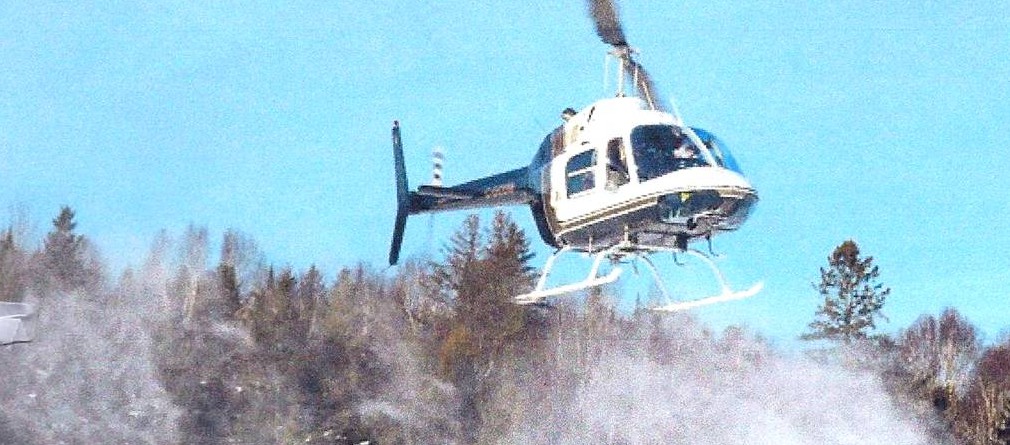

Arctic Hot Tub – For Helicopter Crews Only! | The JetAv Blog by Jack Schweibold
One benefit of being Chief Instructor for the HAI (Helicopter Association International) is exposure to a number of fabulously talented pilots and instructors. Al, Chief Instructor for a Canadian School attended our classes a couple of times, then invited me up to see their facility. He didn’t directly call us “Woosies” but indicated they had a unique operation I needed to see. They were operating a small fleet of Bell 47’s. He baited me by suggesting they might be picking up a turbine ship or two, “How about coming up to teach turbine engines, to help get the new program started?”
Always looking to expand the turbine concept and sell engines as an Allison test pilot, I finally gave in. “OK,” I said, “When is a good time?”
“Let’s plan for next February.” He already knew the date, “Near the end of the month will be just right. I think you will be surprised by the experience.”
“Was thinking more like opening day of Small Mouth Bass season”, I choked back. It was settled, he’d teach a period for our Certified Flight Instructors Course on Canadian regulations and, in exchange, I’d travel to North Bay, Ontario next winter to teach a Turbine Engine Course. I actually forgot about the commitment until he called in January to confirm dates. He said the classroom would be ready by the end of the month; I’d always pictured his college to be a series of existing buildings. I agreed to show up on his schedule.
North Bay sits on Lake Nipissing, 200 miles north of Toronto in Central Ontario. Getting an airline seat in February was no problem, not many people were headed in that direction during the middle of the winter. On landing, he picked me up and then followed with a delightful tour of what we in the U.S. would call a small technical Junior College. The province had a great idea, providing courses geared to segments of commerce needing workers; i.e. subsidize and teach youth a skill for waiting jobs, rather than provide welfare for a bunch of flower children who took basket weaving and poetry on scholarships. But, where were the helicopter students?
They did have an adjacent hangar, but no bodies . . . “We will have to fly by helicopter to meet the students,” Al said. Then he began to tell me the whole process. “The student pilots begin their training in August; by December they have soloed and obtain a modest proficiency by February. We don’t believe in training in the sterile environment of a flat, concrete airport,” he stated. “We teach around the real environment they’ll be operating in at work. Who wants to hire a raw student? Here at OTC we train pilots who are proficient to start working in the bush the day they are licensed. So, on the first of February they pack their ditty bags for 30 days of survival in the wilderness. They fly three place ships, transporting 25-30 students, tents, supplies and a small lumber mill to the lake. They normally get the trees cut, cleared and cabins built on the edge of the ice within the first 7-10 days. They are pretty motivated to get inside and warm with these -20 to -40 degree temperatures. The only flights permitted back to school are for periodic food supplies or medical emergencies. Final flight training continues from a camp built with their hands and flying skills.”
A 25 minute flight took us about 50 miles out in the bush, over solid trees interrupted occasionally by a frozen lake. Not even a vacant cabin broke the emptiness. Finally, we came upon a small lake with a long row of 6-10’ pine trees poking out of the ice every 50 to 100’ leading up to three parking spots on the ice. My thought was we must be making an approach into Santa’s North Pole; they had even erected Christmas trees. Walking up to the cabins we found a group of somber men dedicated to completing chores and training flights. I was a welcome visitor to break their monotony and isolation. My time with the men passed quickly. I think I learned far more than they received from me; for instance, the row of pine trees were planted to provide depth perception hovering under whiteout conditions on open ice and snow. The smallest building at the edge of the lake was a sauna with a hole cut in the ice, dip in for washing, and sit out for drying. No one was around the sauna. I headed home, challenged to do a better job of real life training.
A year later, I repeated the trip in our own Long Ranger. When I landed at the camp there was a new vitality in attitude, a smile on everyone’s face as they met the tasks at hand. Instructors must have done an awesome job this season. Our time together passed like lightning, a total involvement period. The key to this new found joy seemed to radiate from two students, both women, making it the first coed class. I see they must be featuring one of the ladies in their current advertisement for helicopter training. On departure for home at the edge of the lake, it was obvious that this year the sauna was overflowing for the evening dip.
http://www.canadorec.on.ca/programs-courses/helicopter-flight-training

